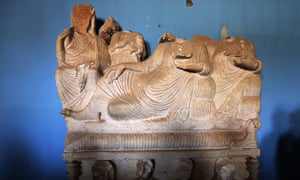
New pictures have emerged of Islamic State’s destruction of 2,000-year-old antiquities in Palmyra that were liberated from Isis control by Syrian government forces earlier this week.
Although more of the external buildings, including the ancient theatre, survived better than previously feared, the destruction inside the museum appears to have been devastating, with wanton disregard for the archaeological and cultural value of the artefacts. Tombs have been broken open and heads systematically removed from statues.
With western camera crews and photographers arriving at the site in the past 24 hours, more detailed reports have emerged of how the jihadis reduced several temples, columns and other treasures to heaps of stone in acts of vandalism to match some of the destructions in the wake of the European religious and political revolutions.
On the rocks at the entrance to the 2,000 years old Temple of Bel, jihadis wrote in black: “The Islamic State. No entry for civilians or brothers [fighters].” While the temple’s outer walls, main entrance and courtyard have survived, the main cella or prayer chamber has been destroyed. Where the shrine of Baal Shamin once stood, only four columns now remain. The remains of the Arch of Triumph, dating back to the era of the Roman emperor Severus in the third century, lie on the ground, leaving only the two columns that once sustained the central crown still standing. It is likely to be relatively easy to restore the arch that was repaired previously in the 1930s.
Syria’s antiquities director, Mamoun Abdulkarim, said it will probably take as long as five years to restore the site, and a conference in Paris is likely to be held shortly to discuss the funding of the enterprise. He had claimed at the time of the capture of the desert town by Isis that many of the most important works had been transported to government-held Damascus, and some of the remaining statues were reproductions.
No comments:
Post a Comment